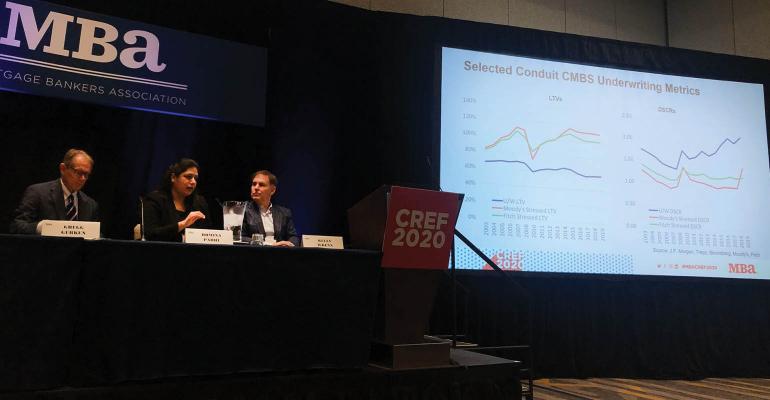Tuesday’s panel discussions at MBA CREF 2020 in San Diego focused on how lenders are trying to mitigate risk in the late stage of a prolonged cycle, the market for construction financing and more insights on how proptech might be changing the business.
Here are some takeaways from Tuesday’s sessions:
- An experienced, reliable sponsor is still among the key things commercial mortgage bankers are looking for when assessing whether they want to underwrite a deal, according to Joel Traut, managing director, real estate, with KKR, who spoke during the “Risky Business: Last Stage Cycle Conversation on Credit, Valuations and Underwriting” panel. KKR is also focusing on class-A and class-B properties since they are likely to be more in demand in the event of a downturn. “And then for us, as transitional lenders, each of the deals we underwrite has some kind of business plan in place,” Traut said.
- Meanwhile, Gregg N. Gerken, executive vice president and head of U.S. commercial real estate lending with TD Bank, said that his team is now looking at new deals as investments rather than as straightforward loans. “It’s not loan to own, it’s loan to ‘what if?” he said of TD Bank’s current underwriting standards. “Too many of our borrowers pass on so many deals just because it’s too rich,” and they can’t afford to make any errors in their projections. Gerken added that there’s riskier, “late-cycle behavior” in the market. “These cycles have happened before—2007 was the peak, everything was great, and look how fast that fell apart,” he said. While the U.S. economy has so far been able to withstand negative events, “at some point there’s going to be an event that the economy just can’t shrug off.”
- Still, even in a worst case scenario, if commercial property values fall by 20 percent from where they are today, that would take the borrowers to where they were in 2016, according to Chris LaBianca, managing director with UBS. So a downturn as severe as the one that took place in 2008-2009 is not expected.
- The amount of debt capital chasing deals in today’s market is leaving some of the more conservative lenders behind and preventing them from growing their lending volumes, according to participants in the “Ground Up: Construction and Rehab Lending Trends” panel. With many people assuming that the market will continue to chug along at its current pace for the foreseeable future, “If you bid a little more conservatively… you are out,” said Gregory R. Reimers, managing director and Northeast market manager, real estate and commercial banking, with JP Morgan Chase. “The amount of liquidity in the market makes every deal hard to win. We see mispriced risk every day.” “If you feel like you’ve done good underwriting [on a construction deal], you are probably not going to win that opportunity,” added Daniel J. Mullinger, executive vice president and co-head of PNC Real Estate Banking.
- Another issue currently facing construction lenders has to do with rising construction costs, “It’s very challenging to make deals work,” said Rob Bedwell, senior vice president, mortgage loans, with Protective Life Insurance Company. “Deals have to be underwritten perfectly” to cushion against rising materials and construction labor prices.
- Because of the oversupply of class-A multifamily projects in some markets, institutional investors are shifting away from that subsector and toward suburban multifamily and mixed-use properties, according to remarks made by Cassandra E. Clark, managing director with JP Morgan Chase, and Stephanie Holder, senior director and head of acquisitions and financing with Invesco Real Estate, during the “A Borrower’s View” panel. When it comes to retail, “We’ve just gotten burned on tenant retention and co-tenancy issues,” noted Holder.
- Proptech adaption continued to be a subject of discussion for the second day in a row during the “CRE and Emerging Tech” panel. According to Steven Powell, executive chairman of SitusAMC, while there are a lot of potentially valuable new software applications in the market, many of them don’t have clients. “We’ve seen a lot of cool ideas—not a lot of clients following those ideas.” As a result, SitusAMC has spent approximately $150 million on buying technology companies over the past three years to bring them in-house and take advantage of their capabilities.
- Successful proptech providers will be those that make a big impact on a small group of people doing a specific task within a commercial real estate company rather than those who try to fundamentally change the whole business from top to bottom, noted Will Mitchell, CEO of Rabbet.
- The areas where there might be the biggest opportunity for proptech to make inroads in the commercial real estate lending sector include data standardization, compressing document processing times and risk mitigation, according to both Powell and Mitchell. “Last year, we sized 18,000 loans,” said Powell. “And our problem is—you can’t have smart people doing dumb work, and so this is an area where we see the most benefit for operations.”

0 comments
Hide comments





